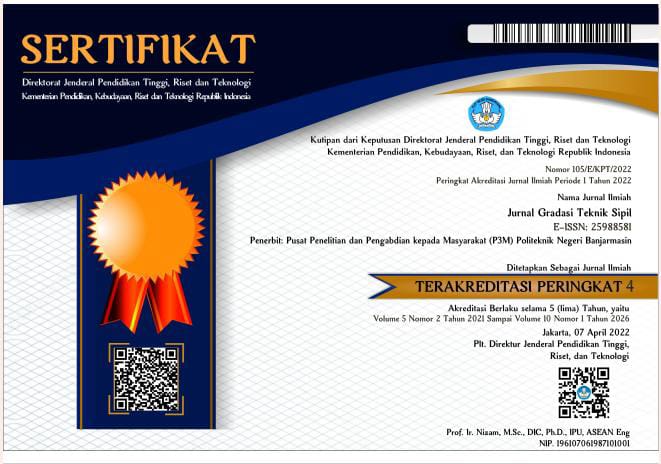EVALUASI PEMODELAN BANJIR 2-D KOTA MANADO
DOI:
https://doi.org/10.31961/gradasi.v5i1.729Keywords:
banjir, evaluasi banjir, genangan banjir, pemodelan banjirAbstract
Permasalahan banjir Kota Manado merupakan permasalahan utama yang wajib ditangani secara komprehensif. Perubahan tata guna lahan, intensitas curah hujan yang sering dan lama, kapasitas tampung sungai yang mengecil, sedimentasi dan sampah, dan perubahan iklim menjadi penyebab terjadinya banjir di Kota Manado. Penelitian ini menggunakan pendekatan model dua dimensi dengan simulasi efek perubahan tata guna lahan dan efek hujan kala ulang serta observasi banjir guna mencari solusi terhadap permasalahan banjir yang sering terjadi di Kota Manado. Hasil dari penelitian ini adalah terjadi perubahan tata guna lahan dan peningkatan luas area terdampak banjir yang menggenangi Kota Manado, di lain hal kapasitas sungai yang kecil, sehingga pemerintah Kota Manado perlu memperbaiki daerah sempadan sungai yang dipadati dan dihuni oleh masyarakat guna meningkatkan kapasitas aliran air di sungai saat musim hujan dengan intensitas lama dan besar
Downloads
References
-------, BMKG Provinsi Sulawesi Utara. 2018. Unpublished report.
-------, BNPB. (2018). [Online] Tersedia: http://bnpb.cloud/dibi/tabel1a [13 September 2018].
-------, BPBD. 2013. Unpublished report.
-------, BPDAS Manado. 2018. Unpublished report.
Akabane Y., S. Kure dan T. Yamada. 2008. Field Observation of Discharge in Urban Catchments and Effects of Urbanization on Runoff Characteristics, Annual Journal of Hydraulic Engineering, JSCE Vol. 52, pp 48-486.
Farid, M., Mano, A., dkk. 2011. Distributed Flood Model for Urbanization Assessment in A Limited-Gauged River Basin. WIT Transactions on Ecology and The Environment, WIT Press (146). p 83-94.
Japan Aerospace eXploration Agency (JAXA). 2018. Unpublished report.
JICA. 2018. Unpublished report.
Kementerian Agraria dan Tata Ruang. 2018. Unpublished report.
Kementerian Pekerjaan Umum dan Perumahan Rakyat. 2018. Unpublished report.
Kure, S., T. Yamada dan H. Kikkawa. 2004. A Study on Multilayer Runoff Analysis Method Considering the Generation of Overland Flow, Annual Journal of Hydraulic Engineering, JSCE, Vol. 49, pp 169-174.
MIKE by DHI. (2018). [Online]. Tersedia: https://www.mikepoweredbydhi.com/ [13 September 2018].
Moe, I. R., Kure, S., dkk. 2017. Development of a Rainfall Runoff and Flood Inundation Model for Jakarta, Indonesia, and Its Sensitivity Analysis of Datasets to Flood Inundation. World Enviromental and Water Resources Congress, Sacramento, California, USA. 21–25 Mei, 2017.
PDAM Manado dan Minahasa. 2018. Unpublished report.
Rinaldi, A., Widodo, L. E., dan Fajar, R. A. 2017. Konduktivitas Hidrolik Material Setara Lanau Pada Tanah Tak Jenuh Air. Prosiding Kongres dan Pertemuan Ilmiah Tahunan Ke-2 Perhimpunan Ahli Airtanah Indonesia. Universitas Gajah Mada, Yogyakarta. 13–15 September 2017.
WorldClim. (2018). Global Climate Data [Online] http://worldclim.org/ [13 September 2018].
Downloads
Published
Issue
Section
License
Copyright (c) 2021 Reza Adhi Fajar, Aris Rinaldi, Dasniari Pohan, Idham Riyando Moe

This work is licensed under a Creative Commons Attribution-NonCommercial-ShareAlike 4.0 International License.
- Hak publikasi atas semua materi naskah jurnal yang diterbitkan/dipublikasikan dalam Jurnal Teknik Sipil ini dipegang oleh Dewan Redaksi dengan sepengetahuan penulis (hak cipta tetap dimiliki penulis).
- Ketentuan legal formal untuk akses artikel digital jurnal elektronik ini tunduk pada ketentuan lisensi Creative Commons Attribution-ShareAlike (CC BY-SA), yang berarti Jurnal Teknik Sipil berhak menyimpan, mengalih media/format-kan, mengelola dalam bentuk pangkalan data (database), merawat, dan mempublikasikan artikel tanpa meminta ijin dari Penulis selama tetap mencantumkan nama Penulis sebagai pemilik Hak Cipta.
- Naskah yang diterbitkan/dipublikasikan secara cetak dan elektronik bersifat open access untuk tujuan pendidikan, penelitian, dan perpustakaan. Selain tujuan tersebut, dewan redaksi tidak bertanggung jawab atas pelanggaran terhadap hukum hak cipta.









